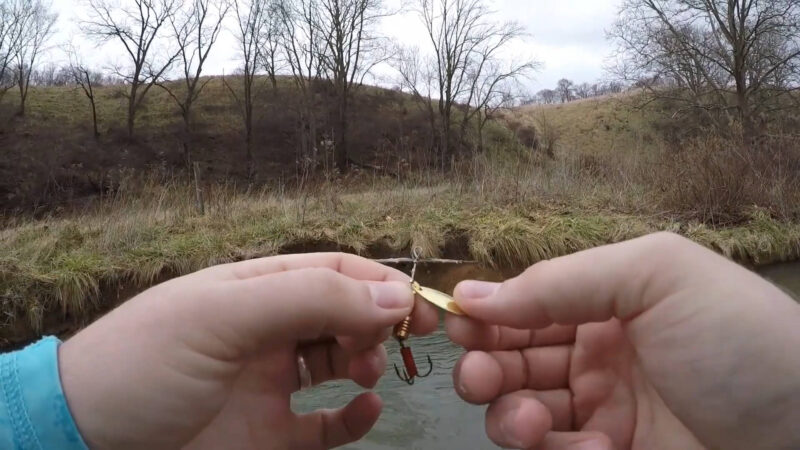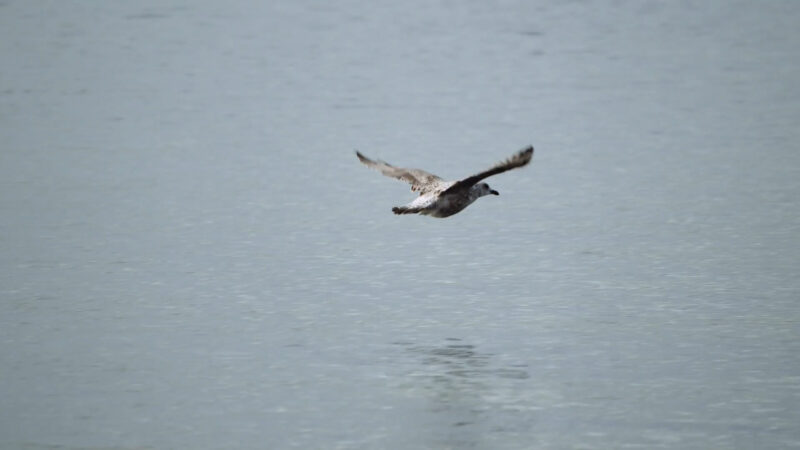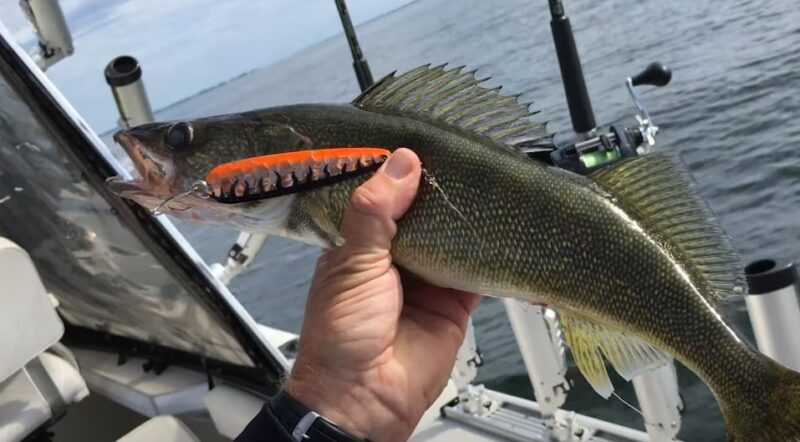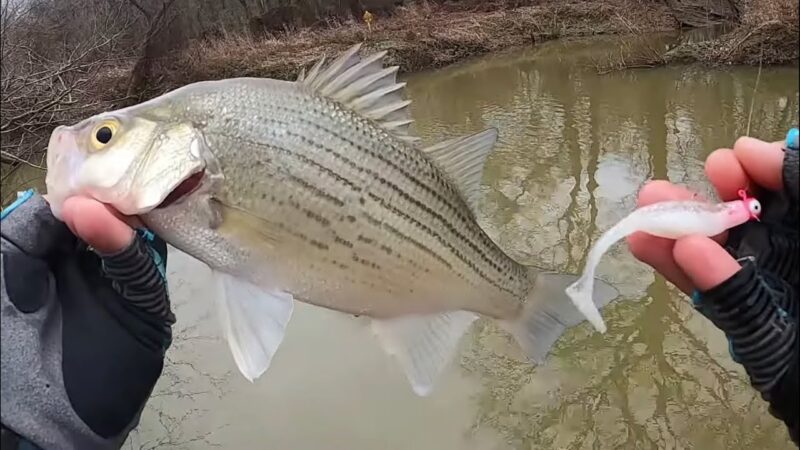Cold weather often drives white bass into deeper waters, where they school together around structures. Knowing where to look and what techniques to use will set you up for success. Small, precise baits are key, and sonar can help you pinpoint the schools.
Watching for bird activity and varying your retrieval speed also prove effective. Patience and strategy lead to impressive catches, even in the coldest months.
This guide covers 11 tips to increase your chances of catching white bass during winter.
Here Are the Tips
- Fish in deep water
- Use small baits
- Focus on shad imitation
- Tightlining from the shore
- Watch for birds
- Vary retrieval speed
- Slow down your presentation
- Target winter hotspots
- Troll with spoons
1. Fish in Deep Water
The best chance of finding them involves targeting depths between 20 and 40 feet. Sonar plays a crucial role in locating schools of white bass, especially around submerged structures.
Best Locations
- Lakes and Reservoirs: White bass gather in deep waters of popular spots like Lake Texoma in Texas and Lake Erie in Ohio. These large bodies of water provide the deep structure that white bass favor.
- Rivers: In rivers such as the Arkansas River, focus on deeper areas where the current slows down. Look for river bars and underwater islands where white bass might school together.
Strategies to Follow
- Sonar: Sonar helps find fish in deeper waters by identifying submerged structures like humps or drop-offs where white bass congregate.
- Timing: Target mornings and late afternoons when fish are most active, especially around deep points and sunken islands.
2. Use Small Baits

Stick to sizes around 1/16 to 1/8 ounce, which allows for better bites from these fish.
Examples
- Inline spinners: Models like Mepps Aglia or Rooster Tail. These lures give off flash and vibration, attracting the fish even in deeper waters. Anglers in Lake Texoma have consistently reported success with these during colder months.
- Jigs: For instance, a 1/16-ounce jig paired with a minnow has brought good results in rivers like the Arkansas River and deep lakes like Lake Cumberland.
Dams on rivers like the Ohio River or Kentucky Lake are perfect spots where white bass hover in deeper pools. Small live minnows or artificial baits work well in these areas.
Slowly reel your small bait near the bottom where white bass gathers. In colder water, a slow and steady approach mimics baitfish movements. Small crankbaits or spoons also work, but always keep size in mind. Larger baits won’t get you consistent bites.
3. Focus on Shad Imitation
As shad are smaller and abundant in many lakes and rivers, using lures that mimic their appearance and behavior increases your chances of success.
Anglers in Lake of the Ozarks or Lake Texoma often rely on small shad-imitating crankbaits like the Rapala Shad Rap. During winter, white bass gather in deeper waters, and these lures do an excellent job of mimicking the erratic swimming patterns of shad.
The swimbait’s size (2-4 inches) closely resembles shad, attracting the attention of white bass that are waiting for prey to pass by.
Technique
Try a slow, steady retrieve, then add sudden jerks or pauses to simulate a struggling or injured baitfish.
4. Tightlining from the Shore

Anglers fishing below dams such as the Kentucky Dam or Wilson Dam on the Tennessee River frequently use tightlining. White bass often school near the base of these structures, where the flow of water brings in baitfish.
Technique and Equipment
- Use a Sinker: Use a sinker at the end of your line to drag your bait to the bottom. A popular rig setup is a small hook baited with live minnows, tied to a dropper line just above the weight.
- Bait Choice: Minnows or small live shad work well. For example, in Lake Texoma, fishermen often use small minnows on light jigs, casting out and waiting for subtle bites.
5. Watch for Birds

White bass, like many predatory fish, follow schools of baitfish in the winter, and birds often give away their location. Seagulls, in particular, can indicate where fish are feeding since they dive to catch the same baitfish that attract the bass.
Once birds are spotted, cast your lure near the area of activity. A small crankbait or jig, especially one mimicking shad, works well in these situations. Adjust your retrieval speed to match the behavior of the fish beneath.
6. Vary Retrieval Speed

White bass respond well to changes in the speed and rhythm of your lure retrieval, especially during winter when they are less aggressive.
In deeper areas like those found at Bull Shoals Lake, where they school near sunken points and river bars, varying your retrieval speed is especially important. The colder water slows their metabolism, so mixing up your speed helps get their attention when other methods might fail.
Technique
- Start Slow: Begin your retrieve at a slow, steady pace to keep your lure near the bottom where the fish are holding. After a few feet, add a quick jerk or sharp pause to break up the pattern. This sudden change often triggers a reaction bite.
- Alternate Speeds: Try speeding up for a short burst, then slowing down again. The idea is to mimic a baitfish trying to flee and tiring out. This erratic movement gets white bass to commit, especially in deeper, colder waters.
7. Slow Down Your Presentation
Slowing down your lure presentation is one of the most effective adjustments you can make to catch more fish during this time. Fishermen at Lake Cumberland report success with small jigs or soft plastics retrieved very slowly along the bottom.
A 1/8-ounce jig head paired with a small plastic trailer, like a Zoom Super Fluke, can be crawled slowly across the bottom to trigger sluggish winter white bass into striking.
Technique
- Let the Lure Sit: After casting, allow your lure to sink to the bottom. Once it settles, give it slight twitches and jerks, but let it sit for longer periods before moving it again. This method works particularly well with jigs or soft plastics.
- Keep Retrieval Smooth and Slow: When using crankbaits or spoons, reel in slowly, allowing the bait to stay closer to the bottom where the fish are feeding. Avoid fast or erratic movements that might scare off sluggish fish.
8. Target Winter Hotspots
Finding these hotspots increases your chances of landing fish, as white bass tend to stay near deeper structure during colder months.
- Rocky Points and Submerged Humps: Anglers in Lake Texoma often target rocky points or submerged humps, where white bass school in the winter. These structures create drop-offs and depth changes that attract baitfish, drawing white bass to these areas.
- Underwater Islands and River Bars: In lakes like Lake Cumberland or Bull Shoals Lake, underwater islands and river bars offer prime winter fishing spots. White bass use these structures as ambush points to catch passing shad or other baitfish.
9. Troll with Spoons

Spoons work well in this technique because their flashy, erratic action mimics the small baitfish that they target. On Bull Shoals Lake and Kentucky Lake, trolling with spoons is a go-to winter strategy.
They often hang out in 20-40 feet of water during winter, and trolling allows you to keep your lure in their strike zone as you move across submerged humps and deep ledges.
Technique
- Use a Swivel: When trolling spoons, always use a swivel to prevent line twist. The constant rotation of the spoon can cause serious tangles without it.
- Slow Trolling: In colder months, they are less active, so slow down your trolling speed. Keep it steady and allow your spoon to flutter and flash as it moves through the water. This will mimic an injured or struggling baitfish, which is irresistible to wintering white bass.
- Vary Depths: Use sonar to identify the depth where white bass are holding and adjust your trolling setup to keep the spoon at that level. This can mean using a downrigger or adding weight to get your lure to the right depth.
FAQs
What is the best time of day to catch white bass in winter?
The best time to catch white bass in winter is typically during the early morning and late afternoon. White bass are more likely to feed during these periods when the light is lower, especially in the colder months when their activity is reduced.
Focus your efforts around these times for the best chance of success.
What type of fishing line should be used for winter white bass fishing?
A light to medium-weight fishing line in the 6 to 12-pound test range is ideal for white bass fishing in winter. Fluorocarbon lines work particularly well because they are nearly invisible underwater, which is important when fishing in clear winter conditions.
A braided line with a fluorocarbon leader can also offer the sensitivity and strength needed for deeper water.
Are there any specific weather conditions that improve winter white bass fishing?
Cold fronts can sometimes trigger feeding activity in white bass, but generally, stable weather conditions are preferred for winter fishing. Sudden drops in temperature might slow down their feeding patterns.
Overcast days, coupled with low winds, tend to be the best conditions, as they reduce the chances of spooking the fish in clear waters.
Can you ice fish for white bass?
Yes, white bass can be caught through the ice in colder regions. Ice fishing for white bass is particularly popular in northern lakes such as Lake Erie or Lake Oahe.
Jigging with small spoons or live bait near the bottom tends to be an effective method. Focus on deeper areas where schools of white bass are likely to gather during the winter months.
Last Words
White bass aren’t going to chase fast-moving bait, so adjusting your speed and being smart about where you fish will lead to better results. Watching for birds, using sonar, or even just knowing where to set up can help you hit those productive spots. Apply these strategies consistently, and winter fishing can be just as rewarding as any other season.

